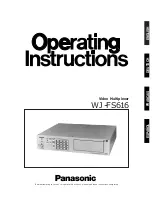
1.
Model no.
2.
LCD display
3.
Power/Auto Power off
4.
Function switch
5.
„+” connector : 20A
6.
„+” connector mA
7.
„-” connector: ground (GND) + c
temperature
8.
„+” connector: voltage, resistance, diode,
continuity test
9.
Transistor connector
10.
Phase indicator LED
11.
Hold/Backlight
DC and AC current measuring
•
Connect the black wire to the „COM” and the
red one to the „mA” connector (max. 200mA)
or the „20A” connector for measuring 200mA
or 20A.
•
Set the function switch to the proper range.
•
Connect the wires to the circuit serially.
•
For measuring current between 200mA and
20A follow the instructions above, but connect
the red wire to the „20A” connector.
Note:
•
If you are unsure about the magnitude of the result,
set the switch to the highest possible range and go
backwards until you reach the correct setting.
•
If only a „1” is displayed on the screen, it signals overload.
Switch to a higher range.
•
Maximum inward current may be 200mA or 20A based on
the selected connector. (The test time may be 10 seconds
max.) Currents too high may melt the fuse which then
needs to be replaced. The 20A range is not protected!
Resistance measuring
•
Connect the black wire to the „COM” and the
red one to the „V/ Ω” connector.
•
Set the function switch to the desired
resistance range.
•
Touch the wires to the measured circuit paralelly.
Note:
make sure that the measured circuit is
not under power!
•
The maximum overload capability for the
connector is 250V RMS (for maximum 10
seconds).
Note:
•
If the measured resistance value is over the maximum
threshold and the device signals overload („1”), select
a higher range. When measuring above 1MΩ it may take
a few seconds for the device to stabilize the displayed
value. This is completely normal for such resistors.
•
If you do not connect a resistor to the connector (or there
is a break) the display will show „1”.
•
If you are measuring a resistor that is part of a circuit
make sure that the circuit is not under power and all
capacitors are discharged.
•
Do not connect inward voltage to the device as it may
lead to damage to the inside circuits.
Capacity measuring
•
Set the function switch to F position.
•
Connect the measuring sensor to the „V/Ω”, and
„COM” connectors.
•
Connect the measured capactitors connectors
to the sensor. Pay attention to the correct
polarity.
Note:
•
If the measured value exceeds the maximum value of
the selected range and the device signals overload („1”),
select a higher range.
•
Unit: 1 nF=10-3 μF or 1000 pF
Do not connect external voltage or current to the
connector! Turn off the power and discharge the capacitors
before measuring. Also discharge the electrolyte
capacitors before measuring!
Diode and continuity test
•
Connect the black measuring wire to the „COM”
and the red to the „V/ Ω” connector. (Note: the
polarity of the red wire is +).
•
Set the function switch to
position.
•
Touch the wires to the diode's connectors.
The screen shows the opening voltage of the
diode.
•
Connect the wires to two points of the circuit. If
the resistance is below 90Ω the device beeps.
Note:
•
If you do not connect a unit to the connectors (or there is
a break) the display will show „1”.
•
During the test 1mA current goes through the diode.
•
The display shows the opening voltage of the diode
in mV and overload if the diode is connected with the
polarity reversed.
Temperature measuring
•
Setting function switch to °C/°F range position,
press “HOLD/BL” key switch to °F.
•
Connect the temperature measuring sensor to
the connectors (pay attention to the polarity,
the black is („-”) and touch the other end to the
measured object.
Transistor hFE test
•
Set the function switch to hFE position.
•
Determine if the transistor is NPN or PNP and place it
in the proper connector.







































